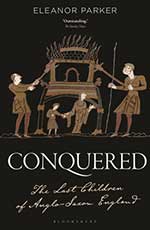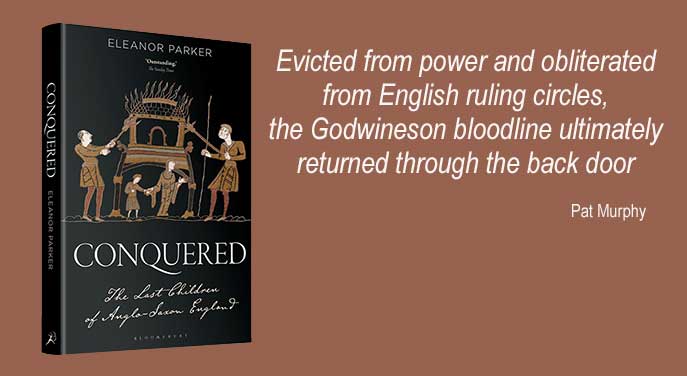 Harold Godwineson, the last Anglo-Saxon king of England, died on the battlefield at Hastings in October 1066. It wasn’t a pretty ending. Whether he was killed by an arrow through the eye (the traditional story), trampled underfoot, or hunted down and (literally) cut to pieces by invading Norman knights remains a matter of speculation.
Harold Godwineson, the last Anglo-Saxon king of England, died on the battlefield at Hastings in October 1066. It wasn’t a pretty ending. Whether he was killed by an arrow through the eye (the traditional story), trampled underfoot, or hunted down and (literally) cut to pieces by invading Norman knights remains a matter of speculation.
For the Godwinesons, it had been a rapid rise and fall. And in one of those twists of fate that add drama to history, the rise part of the trajectory had been facilitated by another invasion a half-century earlier.
Cnut the Great was Danish. By virtue of conquest he became king of England in 1016, subsequently adding the crowns of Denmark and Norway to form a powerful North Sea Empire. His modus operandi in England revolved around balancing Danish and Anglo-Saxon influences. And it was this hybrid approach that facilitated the rise of Harold’s family.
Early in Cnut’s reign, Harold’s father – the Anglo-Saxon Godwine of Wessex – married a connected Danish noblewoman named Gytha, thus forming a union that Oxford medievalist Eleanor Parker describes as exemplifying the new Anglo-Scandinavian elite. Harold, born around 1022, was the second of their nine children.
When Harold ascended to the English throne in January 1066, it was the family’s crowning achievement. They’d made it all the way to the top. But it didn’t last.
 Parker’s book Conquered: The Last Children of Anglo-Saxon England covers the territory. She puts it starkly: “By the end of the year, all this was gone. The most powerful family in England had become a scattered and endangered group of widows, fatherless boys and young women, who now had to consider what future might exist for them in a country under Norman rule.”
Parker’s book Conquered: The Last Children of Anglo-Saxon England covers the territory. She puts it starkly: “By the end of the year, all this was gone. The most powerful family in England had become a scattered and endangered group of widows, fatherless boys and young women, who now had to consider what future might exist for them in a country under Norman rule.”
For the upper class generally, it was wipe out time. Historian Robert Tombs doesn’t mince words: “The Conquest annihilated England’s ruling class, physically and genetically.”
This, however, applied primarily to the male line. Female members of elite families had value to the conquerors. They provided a veneer of continuity.
Within two decades, over 90 per cent of English land was in Norman hands and intermarriage was a means of legitimizing that transfer. So, willing or otherwise, wealthy English widows and heiresses became desirable marriage targets.
And this, too, had repercussions. Producing descendants of mixed lineage, “These women were one means by which Norman-ruled England became Anglo-Norman England.”
| MORE BOOK REVIEWS |
Harold had at least six children at the time of his death, four boys and two girls. Their stories vividly illustrate the scope of the upheaval.
Three of his young sons – Godwine, Edmund and Magnus – decamped to Ireland to seek support from the Mac Murchadas, the friendly ruling family in Ireland’s southeast. Duly armed, they sailed into the Bristol Channel in late 1068. But their attack on the town was repelled.
They tried again the following summer, making landfall in Devon. However, they couldn’t get the necessary traction and their efforts sputtered out. There didn’t seem to be much local appetite for a Godwineson restoration.
From there, at least two of the sons made their way to Denmark, after which their trail goes cold. Historically, they vanished into the mist.
A fourth son of Harold’s, named Ulf, fell into the hands of the new king, William the Conqueror. While his life as a prisoner is a closed book, he did survive and was freed after William’s death in 1087. But his subsequent doings are unknown.
October 1066 changed England forever by Pat Murphy
English history was fundamentally changed within a period of three weeks in the autumn of 1066
If you like medieval drama, The Last Kingdom fits the bill by Pat Murphy
While not scrupulously accurate, it is still quite engrossing
What then of Harold’s two daughters, Gunnhild and Gytha?
Gunnhild remained in England, living at Wilton Abbey from childhood. It was an institution that Parker describes as providing “a refuge for English women left vulnerable by the dispossession of their families at the conquest.”
Around 1093, Gunnhild became embroiled in scandal, leaving Wilton to live with a nobleman named Alan Rufus. Then when he died, she became the partner of his brother.
The archbishop of Canterbury wasn’t pleased; he wrote two nasty letters urging her to get back to the nunnery. Gunnhild, however, didn’t oblige.
It was Gytha, named after the family matriarch, who left the most enduring mark. Through her marriage to Vladimir II, the future Grand Prince of Kiev, she “became the ancestor of many kings and queens across Europe, including English monarchs from Edward III onwards.”
Evicted from power and obliterated from English ruling circles, the Godwineson bloodline ultimately returned through the back door.
Troy Media columnist Pat Murphy casts a history buff’s eye at the goings-on in our world. Never cynical – well, perhaps a little bit. For interview requests, click here.
The opinions expressed by our columnists and contributors are theirs alone and do not inherently or expressly reflect the views of our publication.
© Troy Media
Troy Media is an editorial content provider to media outlets and its own hosted community news outlets across Canada.


